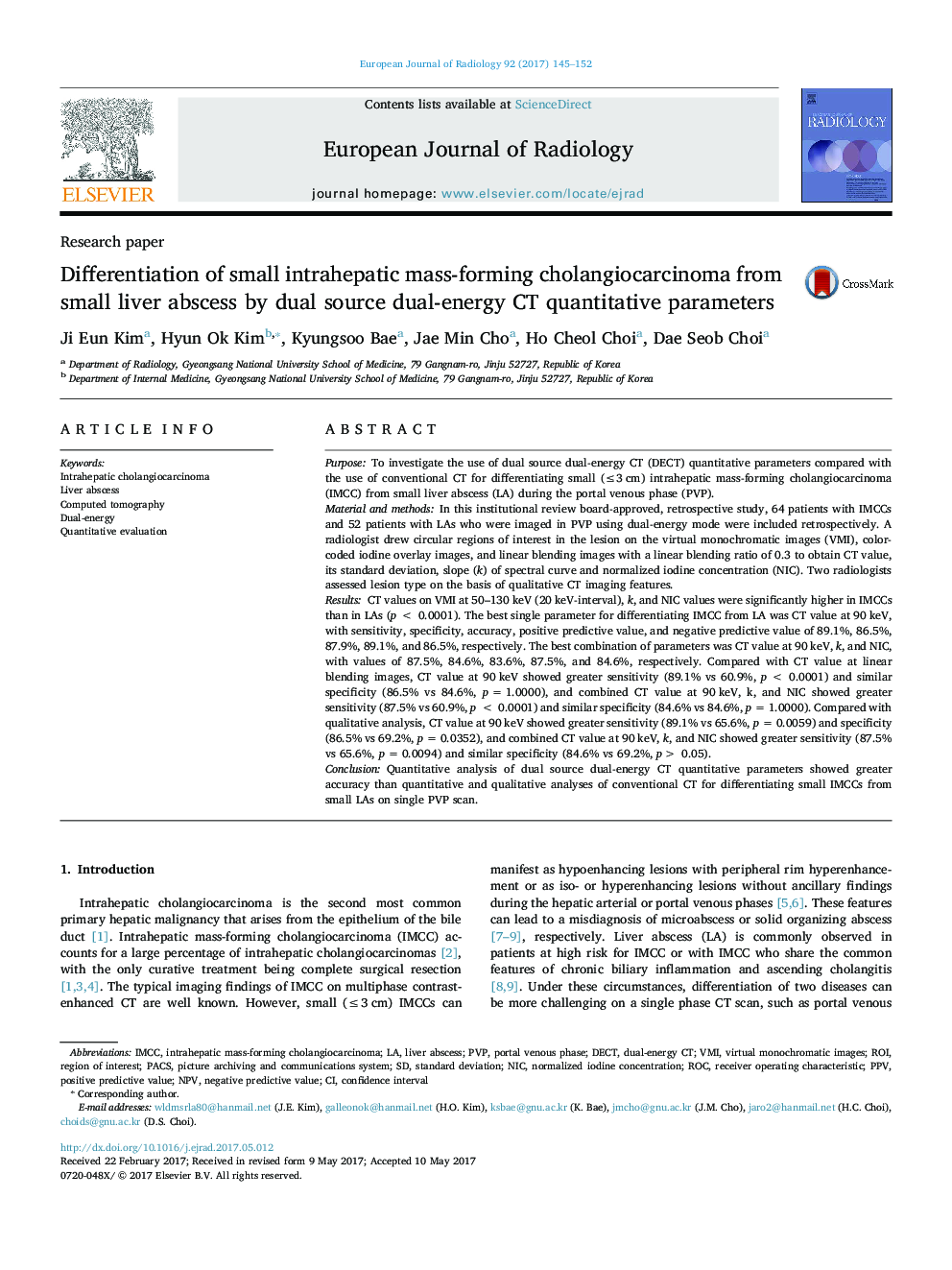| کد مقاله | کد نشریه | سال انتشار | مقاله انگلیسی | نسخه تمام متن |
|---|---|---|---|---|
| 5726183 | 1609728 | 2017 | 8 صفحه PDF | دانلود رایگان |
- CT values on VMI, k and NIC values were significantly higher in IMCCs than in LAs.
- The best single parameter for differentiating IMCC from LA was CT value at 90Â keV.
- The best combined parameters for differentiation were CT value at 90Â keV, k, and NIC.
- Quantitative analysis of DECT improves accuracy for differentiating IMCCs from LAs.
PurposeTo investigate the use of dual source dual-energy CT (DECT) quantitative parameters compared with the use of conventional CT for differentiating small (â¤3 cm) intrahepatic mass-forming cholangiocarcinoma (IMCC) from small liver abscess (LA) during the portal venous phase (PVP).Material and methodsIn this institutional review board-approved, retrospective study, 64 patients with IMCCs and 52 patients with LAs who were imaged in PVP using dual-energy mode were included retrospectively. A radiologist drew circular regions of interest in the lesion on the virtual monochromatic images (VMI), color-coded iodine overlay images, and linear blending images with a linear blending ratio of 0.3 to obtain CT value, its standard deviation, slope (k) of spectral curve and normalized iodine concentration (NIC). Two radiologists assessed lesion type on the basis of qualitative CT imaging features.ResultsCT values on VMI at 50-130 keV (20 keV-interval), k, and NIC values were significantly higher in IMCCs than in LAs (p < 0.0001). The best single parameter for differentiating IMCC from LA was CT value at 90 keV, with sensitivity, specificity, accuracy, positive predictive value, and negative predictive value of 89.1%, 86.5%, 87.9%, 89.1%, and 86.5%, respectively. The best combination of parameters was CT value at 90 keV, k, and NIC, with values of 87.5%, 84.6%, 83.6%, 87.5%, and 84.6%, respectively. Compared with CT value at linear blending images, CT value at 90 keV showed greater sensitivity (89.1% vs 60.9%, p < 0.0001) and similar specificity (86.5% vs 84.6%, p = 1.0000), and combined CT value at 90 keV, k, and NIC showed greater sensitivity (87.5% vs 60.9%, p < 0.0001) and similar specificity (84.6% vs 84.6%, p = 1.0000). Compared with qualitative analysis, CT value at 90 keV showed greater sensitivity (89.1% vs 65.6%, p = 0.0059) and specificity (86.5% vs 69.2%, p = 0.0352), and combined CT value at 90 keV, k, and NIC showed greater sensitivity (87.5% vs 65.6%, p = 0.0094) and similar specificity (84.6% vs 69.2%, p > 0.05).ConclusionQuantitative analysis of dual source dual-energy CT quantitative parameters showed greater accuracy than quantitative and qualitative analyses of conventional CT for differentiating small IMCCs from small LAs on single PVP scan.
Journal: European Journal of Radiology - Volume 92, July 2017, Pages 145-152
